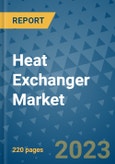1. Executive Summary
1.1. Global Heat Exchanger Market Snapshot
1.2. Key Market Trends
1.3. Future Projections
1.4. Analyst Recommendations
2. Market Overview
2.1. Market Definitions and Segmentations
2.2. Market Dynamics
2.2.1. Drivers
2.2.1.1. Driver A
2.2.1.2. Driver B
2.2.1.3. Driver C
2.2.2. Restraints
2.2.2.1. Restraint 1
2.2.2.2. Restraint 2
2.2.3. Market Opportunities Matrix
2.3. Value Chain Analysis
2.4. Porter’s Five Forces Analysis
2.5. Covid-19 Impact Analysis
2.5.1. Pre-covid and Post-covid Scenario
2.5.2. Supply Impact
2.5.3. Demand Impact
2.6. Government Regulations
2.7. Technology Landscape
2.8. Economic Analysis
2.9. PESTLE
3. Global Heat Exchanger Market Outlook, 2019 - 2030
3.1. Global Heat Exchanger Market Outlook, by Type, Value (US$ Mn), 2019 - 2030
3.1.1. Key Highlights
3.1.1.1. Shell & Tube
3.1.1.1.1. Plate & Frame
3.1.1.1.2. Braze
3.1.1.1.3. Gasketed
3.1.1.2. Welded
3.1.1.3. Misc.
3.1.1.4. Air Cooled
3.1.1.5. Misc.
3.2. Global Heat Exchanger Market Outlook, by End-user, Value (US$ Mn), 2019 - 2030
3.2.1. Key Highlights
3.2.1.1. Chemical
3.2.1.2. Energy
3.2.1.3. HVAC & Refrigeration
3.2.1.4. Food & Beverage
3.2.1.5. Power Generation
3.2.1.6. Pulp & Paper
3.2.1.7. Misc.
3.3. Global Heat Exchanger Market Outlook, by Region, Value (US$ Mn), 2019 - 2030
3.3.1. Key Highlights
3.3.1.1. North America
3.3.1.2. Europe
3.3.1.3. Asia Pacific
3.3.1.4. Latin America
3.3.1.5. Middle East & Africa
3.3.2. BPS Analysis/Market Attractiveness Analysis
4. North America Heat Exchanger Market Outlook, 2019 - 2030
4.1. North America Heat Exchanger Market Outlook, by Type, Value (US$ Mn), 2019 - 2030
4.1.1. Key Highlights
4.1.1.1. Shell & Tube
4.1.1.1.1. Plate & Frame
4.1.1.1.2. Braze
4.1.1.1.3. Gasketed
4.1.1.2. Welded
4.1.1.3. Misc.
4.1.1.4. Air Cooled
4.1.1.5. Misc.
4.2. North America Heat Exchanger Market Outlook, by End-user, Value (US$ Mn), 2019 - 2030
4.2.1. Key Highlights
4.2.1.1. Chemical
4.2.1.2. Energy
4.2.1.3. HVAC & Refrigeration
4.2.1.4. Food & Beverage
4.2.1.5. Power Generation
4.2.1.6. Pulp & Paper
4.2.1.7. Misc.
4.3. North America Heat Exchanger Market Outlook, by Country, Value (US$ Mn), 2019 - 2030
4.3.1. Key Highlights
4.3.1.1. U.S.
4.3.1.2. Canada
4.3.2. BPS Analysis/Market Attractiveness Analysis
5. Europe Heat Exchanger Market Outlook, 2019 - 2030
5.1. Europe Heat Exchanger Market Outlook, by Type, Value (US$ Mn), 2019 - 2030
5.1.1. Key Highlights
5.1.1.1. Shell & Tube
5.1.1.1.1. Plate & Frame
5.1.1.1.2. Braze
5.1.1.1.3. Gasketed
5.1.1.2. Welded
5.1.1.3. Misc.
5.1.1.4. Air Cooled
5.1.1.5. Misc.
5.2. Europe Heat Exchanger Market Outlook, by End-user, Value (US$ Mn), 2019 - 2030
5.2.1. Key Highlights
5.2.1.1. Chemical
5.2.1.2. Energy
5.2.1.3. HVAC & Refrigeration
5.2.1.4. Food & Beverage
5.2.1.5. Power Generation
5.2.1.6. Pulp & Paper
5.2.1.7. Misc.
5.3. Europe Heat Exchanger Market Outlook, by Country, Value (US$ Mn), 2019 - 2030
5.3.1. Key Highlights
5.3.1.1. Germany
5.3.1.2. France
5.3.1.3. U.K.
5.3.1.4. Italy
5.3.1.5. Spain
5.3.1.6. Russia
5.3.1.7. Rest of Europe
5.3.2. BPS Analysis/Market Attractiveness Analysis
6. Asia Pacific Heat Exchanger Market Outlook, 2019 - 2030
6.1. Asia Pacific Heat Exchanger Market Outlook, by Type, Value (US$ Mn), 2019 - 2030
6.1.1. Key Highlights
6.1.1.1. Shell & Tube
6.1.1.1.1. Plate & Frame
6.1.1.1.2. Braze
6.1.1.1.3. Gasketed
6.1.1.2. Welded
6.1.1.3. Misc.
6.1.1.4. Air Cooled
6.1.1.5. Misc.
6.2. Asia Pacific Heat Exchanger Market Outlook, by End-user, Value (US$ Mn), 2019 - 2030
6.2.1. Key Highlights
6.2.1.1. Chemical
6.2.1.2. Energy
6.2.1.3. HVAC & Refrigeration
6.2.1.4. Food & Beverage
6.2.1.5. Power Generation
6.2.1.6. Pulp & Paper
6.2.1.7. Misc.
6.3. Asia Pacific Heat Exchanger Market Outlook, by Country, Value (US$ Mn), 2019 - 2030
6.3.1. Key Highlights
6.3.1.1. China
6.3.1.2. Japan
6.3.1.3. South Korea
6.3.1.4. India
6.3.1.5. Southeast Asia
6.3.1.6. Rest of Asia Pacific
6.3.2. BPS Analysis/Market Attractiveness Analysis
7. Latin America Heat Exchanger Market Outlook, 2019 - 2030
7.1. Latin America Heat Exchanger Market Outlook, by Type, Value (US$ Mn), 2019 - 2030
7.1.1. Key Highlights
7.1.1.1. Shell & Tube
7.1.1.1.1. Plate & Frame
7.1.1.1.2. Braze
7.1.1.1.3. Gasketed
7.1.1.2. Welded
7.1.1.3. Misc.
7.1.1.4. Air Cooled
7.1.1.5. Misc.
7.2. Latin America Heat Exchanger Market Outlook, by End-user, Value (US$ Mn), 2019 - 2030
7.2.1. Key Highlights
7.2.1.1. Chemical
7.2.1.2. Energy
7.2.1.3. HVAC & Refrigeration
7.2.1.4. Food & Beverage
7.2.1.5. Power Generation
7.2.1.6. Pulp & Paper
7.2.1.7. Misc.
7.3. Latin America Heat Exchanger Market Outlook, by Country, Value (US$ Mn), 2019 - 2030
7.3.1. Key Highlights
7.3.1.1. Brazil
7.3.1.2. Mexico
7.3.1.3. Rest of Latin America
7.3.2. BPS Analysis/Market Attractiveness Analysis
8. Middle East & Africa Heat Exchanger Market Outlook, 2019 - 2030
8.1. Middle East & Africa Heat Exchanger Market Outlook, by Type, Value (US$ Mn), 2019 - 2030
8.1.1. Key Highlights
8.1.1.1. Shell & Tube
8.1.1.1.1. Plate & Frame
8.1.1.1.2. Braze
8.1.1.1.3. Gasketed
8.1.1.2. Welded
8.1.1.3. Misc.
8.1.1.4. Air Cooled
8.1.1.5. Misc.
8.2. Middle East & Africa Heat Exchanger Market Outlook, by End-user, Value (US$ Mn), 2019 - 2030
8.2.1. Key Highlights
8.2.1.1. Chemical
8.2.1.2. Energy
8.2.1.3. HVAC & Refrigeration
8.2.1.4. Food & Beverage
8.2.1.5. Power Generation
8.2.1.6. Pulp & Paper
8.2.1.7. Misc.
8.3. Middle East & Africa Heat Exchanger Market Outlook, by Country, Value (US$ Mn), 2019 - 2030
8.3.1. Key Highlights
8.3.1.1. GCC
8.3.1.2. South Africa
8.3.1.3. Rest of Middle East & Africa
8.3.2. BPS Analysis/Market Attractiveness Analysis
9. Competitive Landscape
9.1. Company Market Share Analysis, 2022
9.2. Competitive Dashboard
9.3. Company Profiles
9.3.1. Alfa Laval
9.3.1.1. Company Overview
9.3.1.2. Product Portfolio
9.3.1.3. Financial Overview
9.3.1.4. Business Strategies and Development
9.3.2. Danfoss
9.3.3. Xylem Inc.
9.3.4. Güntner Group GmbH
9.3.5. General Electric Company
9.3.6. Mersen Group
9.3.7. Johnson Controls International
9.3.8. Kelvion Holding GmbH
9.3.9. Thermax Ltd.
9.3.10. The Nuberg HFD
9.3.11. HISAKA WORKS, LTD.
9.3.12. ACCESSEN Group
9.3.13. Koch Heat Transfer
10. Appendix
10.1. Research Methodology
10.2. Report Assumptions
10.3. Acronyms and Abbreviations








